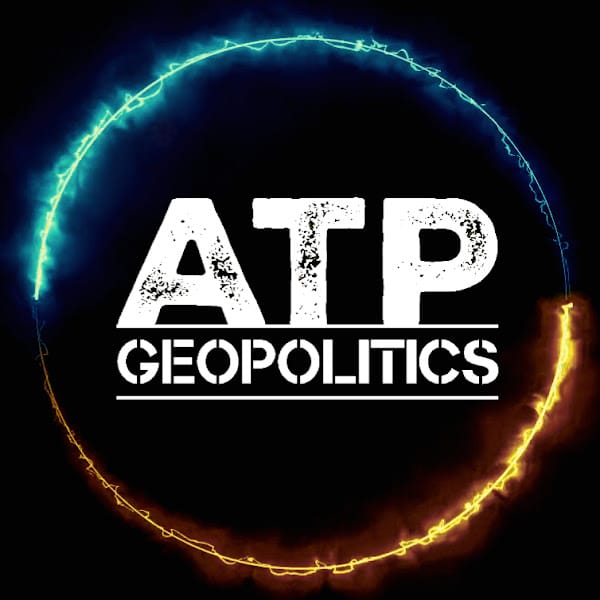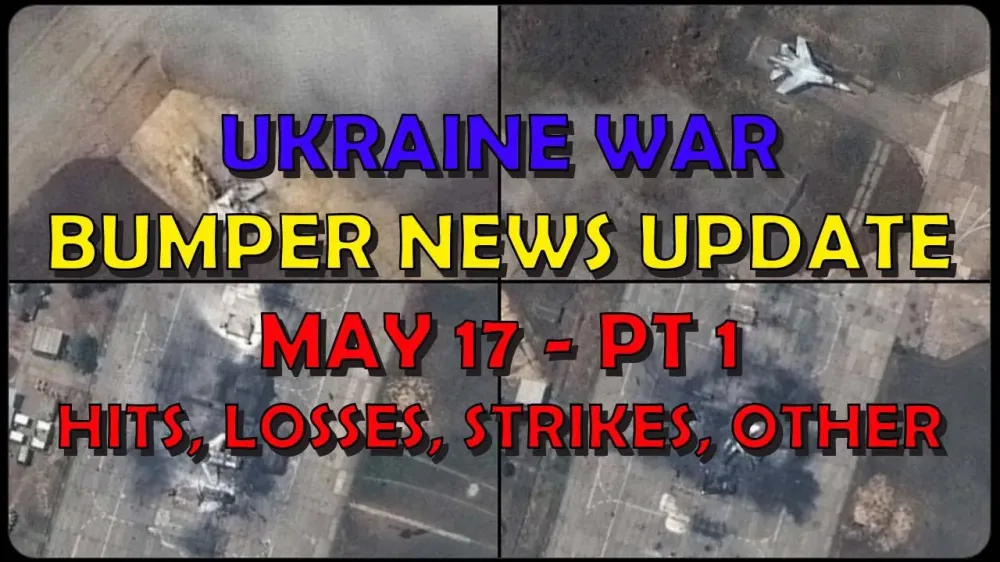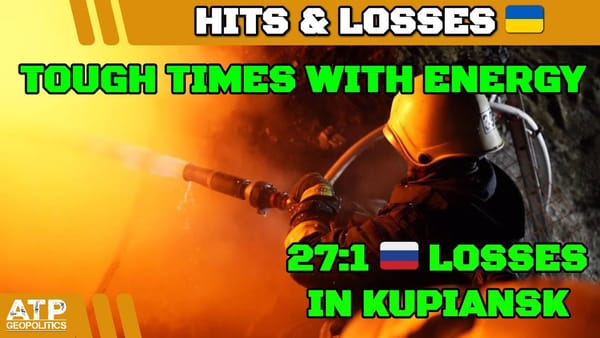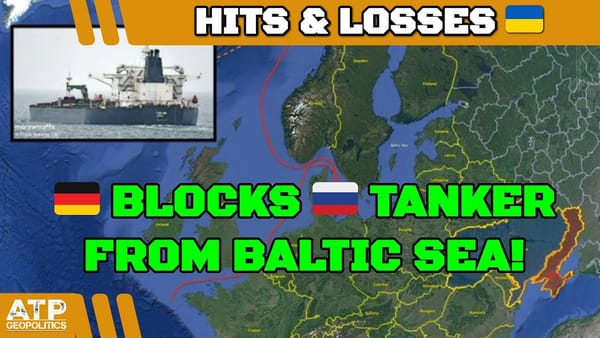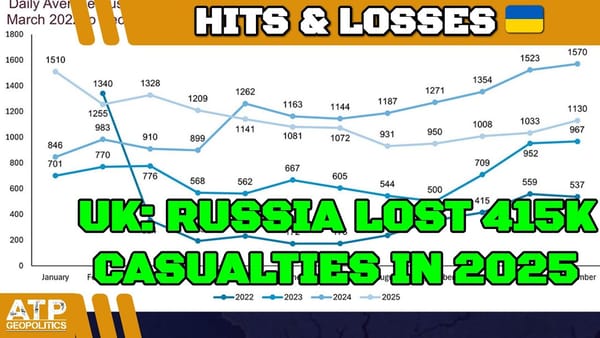Ukraine War Update BUMPER NEWS: Pt 1 - Overnight & Other News
Table of Contents 📖
"For the first time in the war, Ukraine has enough artillery shells to fight against Russia. No brigades have shell shortages, says Zelensky."
Hello Team
🎦 00:00-00:20⏩
Jonathan welcomes viewers to an "absolutely bumper" Ukraine War News Update. He explains that this is Part 1 of this update, which will focus on overnight news and other developments. He encourages viewers to watch his earlier breaking news video on the significant drone attacks that took place overnight. Today's video will focus on the usual hits and losses update for 17/05/2024. He acknowledges the volume of information to be covered and aims to deliver it swiftly for the benefit of viewers.
Return to top⤴️
🪦 DISCLAIMER FOR GENERAL STAFF LOSSES DATA
- These are real people with real lives and real families who love them. Don’t let the numbers sap your humanity.
- These numbers probably aren’t accurate but they’re the best we have and we don’t need them to be accurate to be indicative of patterns of activity.
- All losses are estimates. Losses cannot be counted with accuracy because of the conditions on the ground.
- Both sides would see it to be of their advantage to minimize their own losses maximize the other side’s losses.
- Neither side releases their losses but we have enough transparency from the Ukrainian side to have confidence in they are indicative.
- Personnel losses are hard to count. If a soldier gets injured, heals up, and returns to the front line only to get injured again, is that one loss or two? Also, how to deal with losses from PMC’s or soldiers fighting with RF from occupied territories?
- Equipment losses are hard to count. If an AA complex involves several parts and one part gets disabled, is that a loss, or a fraction of a loss? If a tank gets disabled, repaired, back into the fight, then disabled again, is that one lost tank or two?
- All recorded losses are vulnerable to multiple reporting. We have already seen numerous cases of multiple drones in the air reporting the same loss from different angles as multiple engagements.
- Losses are not always reported on the same day they occurred. It is frequent that drone losses are reported at least 24 hours after other terrestrial equipment losses. Certain losses may not be reported for days or weeks for military intelligence reasons.
General Staff Ukraine Hits and Losses 17/05/2024
🎦 00:21-02:47⏩
Jonathan reports exceptionally high figures in the latest General Staff of the Armed Forces of Ukraine's estimated Russian losses. Noteworthy figures include:
- Personnel: 1,410
- Tanks: 18
- Artillery systems: 38
- Vehicles and fuel tanks: 56
Jonathan speculates that renewed Russian offensive operations in northern Ukraine, specifically in the Kharkiv and Sumy oblasts, are contributing to these substantial losses. He analyses the figures, highlighting that the high number of Russian vehicle and fuel tank losses suggests Ukrainian forces are putting up stiff resistance. Jonathan emphasizes the dedication and resilience of the Russian forces, who are persistently striving to achieve their objectives despite these setbacks.
Return to top⤴️
Andrew Perpetua's Estimated Russian Equipment Losses 16/05/2024
🎦 02:47-08:11⏩
Jonathan analyses visually confirmed Russian equipment losses based on the latest data from Andrew Perpetua (@AndrewPerpetua), highlighting a two-to-one loss ratio in favour of the Ukrainians for 16/05/2024. He analyses the significance of individual losses, focusing on:
- Ukrainian Losses: A substantial number of artillery pieces, including M777s and Bohdana self-propelled howitzers, have been lost. Additionally, two Bradley Fighting Vehicles have been damaged, and one Armada infantry fighting vehicle (IFV) has been destroyed. A significant number of M113 armoured personnel carriers (APCs) were also lost, alongside Kozak MRAPs and MaxxPro MRAPs. Jonathan observes an unusually high number of civilian four-wheel-drive vehicles. This suggests that Ukrainian forces are actively utilising mechanised units in the Kharkiv region, which is unusual given the static nature of the frontline in recent months.
- Russian Losses: A Strela-10 surface-to-air missile system, a Zoopark-1 counter-battery radar system, and two additional radar systems represent significant losses for the Russians. These losses alone likely outweigh the monetary value of Ukrainian losses, but Jonathan stresses that value extends beyond monetary worth, encompassing tactical and strategic implications. He notes that the destruction of a TOS-1A thermobaric multiple launch rocket system is significant. Jonathan also highlights the loss of numerous Russian tanks, including a T-90M, a variety of BMPs and BTRs. He contrasts this with the recent vulnerability of adapted Russian tanks, often referred to as "garden sheds", suggesting a possible shift in the effectiveness of this particular modification. Finally, he points out that while Ukrainian losses are notable, they are overshadowed by the substantial equipment losses suffered by the Russians.
Jonathan suggests that the high number of Ukrainian vehicle losses in the Kharkiv region is likely a result of the Russians exploiting their ability to launch attacks from within their own territory. This advantage potentially stems from the United States' stance on restricting the use of American-supplied weapons within Russia. Jonathan expresses strong disapproval of this policy, believing that it gives Russia an unfair advantage in the conflict. He argues that this restriction is counterproductive and calls for a reassessment of the policy.
Return to top⤴️
Andrew Perpetua's Estimated Russian Equipment Losses 17/05/2024
🎦 08:11-11:39⏩
Jonathan examines Andrew Perpetua's (@AndrewPerpetua) latest data on visually confirmed losses for 17/05/2024. While the initial assessment suggests a 2.5 or 3 to 1 loss ratio in favour of Russia, Jonathan argues that this is skewed by the inclusion of seven Starlink satellite internet systems in the Ukrainian losses. He questions the inclusion of Starlinks on the list, suggesting that while valuable, they are not comparable to traditional military equipment. Excluding the Starlinks, Jonathan suggests the loss ratio looks much better for Ukraine. He analyzes the equipment losses:
- Ukrainian Losses: A Grad multiple launch rocket system, two M777 howitzers, a CV90 infantry fighting vehicle, and several tanks represent notable Ukrainian losses.
- Russian Losses: The destruction of four aircraft at Belbek Air Base in Crimea is a significant blow to the Russians. Visually confirmed losses include two MiG-31s, a MiG-29 and an Su-27, although there are unconfirmed reports of further aircraft being damaged or destroyed. A BREM-1 armoured recovery vehicle was also destroyed, along with an assortment of artillery pieces. Jonathan emphasizes the loss of a substantial number of Russian tanks, including a T-90M, T-80BVs, T-72s, T-64s, and T-62s. These losses, coupled with the destruction of four aircraft and other equipment, significantly outweigh Ukrainian losses.
Jonathan concludes that the Russians have suffered a "very bad day at the office".
Return to top⤴️
Ukrainian Offensive Operations in Kharkiv Oblast
🎦 11:39-12:30⏩
Jonathan reports that the situation in the town of Vovchansk, Kharkiv Oblast is now under Ukrainian control. The Ukrainian General Staff has reported significant Russian losses in this area since 16/05/2024, including 160 personnel and 21 pieces of military equipment. It appears that the Russians are experiencing heavier losses in this area than before. Jonathan observes that while both sides are sustaining losses in the Kharkiv region, Ukrainian losses seem to be more heavily concentrated in vehicles.
Return to top⤴️
Russian Aircraft Losses at Belbek Air Base, Crimea
🎦 12:30-14:27⏩
Jonathan provides an update on the situation at Belbek Air Base near Sevastopol in Russian-occupied Crimea. He highlights the significance of this airbase, noting that it houses MiG-31K fighter jets, designed to carry Kh-47M2 Kinzhal hypersonic missiles. He states that open-source intelligence (OSINT) investigators and satellite imagery analysis indicate substantial Russian losses at the base, with various sources reporting varying figures. However, the consensus is that at least four Russian aircraft, including two MiG-31Ks, have been destroyed, along with an ammunition warehouse. Jonathan notes that Ukraine Battle Map reports the destruction of two MiG-31 fighter jets and damage to three Su-27s over the previous two days. Additionally, they have confirmed the destruction of an S-400 92N6E radar, two S-400 launchers, warehouses containing fuel, lubricants, MiG-31 and Su-30 missiles, and the deaths of 13 Russian personnel at Belbek Air Base as a result of Ukrainian strikes. Jonathan highlights the considerable cost these losses inflict on the Russians.
Return to top⤴️
Ukrainian Drone and Artillery Attacks
🎦 14:27-16:26⏩
Jonathan highlights the increasing volume of footage released by Ukrainian drone operators documenting their successes against Russian forces. He shows footage of Ukrainian FPV drone pilots from the 110th Assault Brigade destroying two Russian tanks within the Kursk region of Russia. Jonathan considers this strike significant as it suggests preparations for a potential Russian offensive into the Sumy Oblast of Ukraine. He argues that the presence of Russian tanks so close to the border, when they are in short supply on the frontlines, indicates an intention to use them in this region. Jonathan then presents footage from near Mariinka, where Russian forces attempted to breach Ukrainian defences. Ukrainian forces repelled this attack, inflicting losses on the Russian 33rd Mechanised Brigade, including the destruction of two tanks, two infantry fighting vehicles, and an unspecified number of personnel. He shows footage of Ukrainian artillery, including cluster munitions, targeting Russian forces and equipment. He notes the profound impact the conflict has had on the Ukrainian landscape and underscores the immense volume of artillery shells both sides are expending daily.
Return to top⤴️
Ukrainian Drone Attacks on Russian Territory and Occupied Crimea
🎦 16:26-17:23⏩
Jonathan revisits the topic of Ukraine's recent drone attacks, which targeted various locations in Russia and Russian-occupied Crimea, including Sevastopol, Novorossiysk, Tuapse, and Tula. Footage has emerged showing the aftermath of strikes in Tula, a Russian city with significant military industrial facilities. The target was reportedly a state-owned enterprise of the Russian defence complex, Basalt, a critical facility responsible for the production and supply of ammunition and weapons systems for the Russian Armed Forces. Jonathan notes the attack's strategic significance and speculates on the extent of the damage. He questions whether the strikes successfully halted production at the facility.
Return to top⤴️
Analysis of Ukraine's Repeated Drone Strikes on Belbek Air Base
🎦 17:23-19:40⏩
Jonathan discusses Ukraine's strategy of conducting repeated drone strikes on Belbek Air Base. Referencing an analysis by an Austrian retired colonel, he outlines the rationale behind targeting the same location on consecutive nights:
- Criticality of Belbek Air Base: Jonathan emphasizes the strategic importance of Belbek Air Base to Russian operations. He argues that abandoning the base is not an option for the Russians, forcing them to prioritize repairs and resupply efforts after each attack.
- Targeting Combat Engineering Systems: The retired colonel highlights the limited availability of specialized combat engineering systems designed for airfield repair and refitting. These systems are crucial for rapidly restoring operational capacity following an attack. By striking Belbek on consecutive nights, Ukraine likely aimed to inflict further damage on these systems, further degrading Russia's ability to repair the airfield and restore its defensive capabilities.
Jonathan underscores the significance of degrading Belbek's operational capacity. By targeting the base and its support infrastructure, Ukraine undermines Russia's ability to effectively defend its positions in Crimea. He argues that repeated strikes on Belbek are a strategically sound decision with significant implications for the overall conflict. Jonathan expresses frustration that the West did not provide Ukraine with the necessary equipment, such as long-range missiles like ATACMS, sooner. He believes that providing this equipment earlier could have significantly altered the course of the conflict.
Return to top⤴️
The Evolving Role of Crimea in the War
🎦 19:40-21:56⏩
Jonathan ponders if the recent escalation of attacks signals the emergence of a new front in the war, specifically in Crimea. He observes that while much of the world's attention is focused on the static frontline in eastern Ukraine, the fight for Crimea is potentially more strategically significant. Jonathan draws parallels to historical analyses by U.S. strategists, including himself, who have long argued that undermining Russia's ability to operate and maintain its presence in Crimea is crucial to achieving a Ukrainian victory. Jonathan highlights the successful targeting of key air and helicopter bases in Berdyansk, Luhansk, Belbek, and Dzhankoi, significantly impacting Russia's ability to utilize air power effectively in the conflict. He speculates that if Ukraine had access to long-range ATACMS missiles and F-16 fighter jets earlier in the conflict, the dynamics of the war might be significantly different. He points to the potential for these weapons systems to neutralize Russian artillery positions and disrupt their logistical operations. Jonathan expresses frustration with the West's delayed provision of advanced weapon systems to Ukraine. He contends that the West's cautious approach, characterized by incremental and delayed military aid, has prolonged the conflict and hindered Ukraine's ability to achieve decisive victories. He argues that Ukraine's effective utilization of recently supplied weapons, such as Storm Shadow cruise missiles, demonstrates their capacity to employ these systems responsibly and strategically. Jonathan criticizes the West's risk-averse approach, stating that the delay in providing these vital assets has only served to prolong the conflict. He concludes that the evidence clearly demonstrates Ukraine's capability to effectively utilize these weapons without causing unnecessary escalation.
Return to top⤴️
Ukraine's Use of Electronic Warfare to Counter Russian Drones
🎦 21:56-25:10⏩
Jonathan discusses Ukraine's increasingly sophisticated use of electronic warfare (EW) to counter Russian drones and missiles, specifically referencing insights shared by John Ridge and Soheyl Flash on Twitter. Key takeaways from the discussion include:
- GNSS Jamming and Spoofing: Ukraine is employing a combination of GNSS jamming, which disrupts Russian navigation systems, and spoofing, which involves feeding false location data to mislead enemy drones and missiles.
- Luring Enemy Drones and Missiles into Air Defence Traps: Jonathan explains that Ukrainian forces are using spoofing techniques to redirect incoming Russian drones and missiles towards Ukrainian air defence positions. By manipulating their navigation systems, Ukrainian forces can effectively lure these threats into pre-prepared kill zones.
- Exploiting Russia's Reliance on Chinese Electronics: John Ridge highlights Russia's reliance on cheaper, less sophisticated Chinese-made radios and electronic systems. This dependence makes Russian drones and missiles more susceptible to Ukrainian electronic warfare tactics.
- Challenges Faced by Ukraine in EW Operations: While Ukraine is achieving notable success in electronic warfare, challenges remain. A Twitter user named Just in Case (@case\_just) highlights the shortage of larger electronic warfare systems, estimating that Ukraine only has 30% of what is required. He attributes this to bureaucratic hurdles, profit-driven motives, and a lack of standardised equipment. Furthermore, Just in Case draws attention to the difficulties faced at the front lines, where a lack of coordination and standardization in EW equipment often leads to interference between friendly and enemy drone operations.
Jonathan acknowledges the high cost and limited availability of Western EW systems. He suggests that Ukraine is increasingly relying on its own defence industry to develop and produce effective electronic warfare countermeasures tailored to the specific challenges of the conflict. Jonathan emphasizes the invaluable expertise gained by Ukraine through real-world combat experience, which has enabled them to develop innovative solutions and adapt to the evolving nature of modern warfare. He believes that Ukraine's first-hand knowledge of the battlefield surpasses that of many Western nations. This positions them as invaluable partners in developing and refining EW technologies that can effectively counter emerging threats.
Return to top⤴️
Analysis of Wreckage: Ukrainian Naval Drone Armed with R-73 Air-to-Air Missiles
🎦 25:10-26:18⏩
Jonathan examines images of the remnants of Ukrainian naval drones that were allegedly involved in attacks on Crimea over the preceding two nights. One of the drone wrecks appears to be equipped with an R-73 air-to-air missile. He expresses uncertainty about the outcome of these attacks, speculating that they were likely repelled by the Russians, given the lack of information regarding significant damage or disruption. Jonathan acknowledges the possibility that one of these drones was the one previously shown being engaged by a Russian helicopter. While the drone in that footage successfully launched its missile, it did not appear to sink, leading Jonathan to believe it might be among the wreckage shown.
Return to top⤴️
Comparison of Russian and Ukrainian Drone Warfare Capabilities
🎦 26:18-27:25⏩
Jonathan contrasts the drone warfare capabilities of Russia and Ukraine. He points out the disparity in drone usage: Russia launched 20 Shahed drones into Ukraine, which were all shot down, whereas Ukraine sent over 105 drones into Russia during their recent large-scale attack. He believes this disparity in drone usage marks a turning point in the conflict. He highlights that while the Russian Ministry of Defence claims to have shot down the majority of Ukrainian drones, the sheer volume of video evidence suggests otherwise. This discrepancy, Jonathan suggests, indicates that Russia is downplaying the extent of Ukrainian drone strikes within their territory. Jonathan highlights the strategic advantage Ukraine possesses in drone warfare. He observes that Ukraine's smaller size allows for more efficient air defence coverage, making it harder for Russian drones to penetrate. Conversely, Russia's vast territory and the Ukrainians' ability to exploit weaknesses in their air defence network makes it challenging for them to intercept all incoming Ukrainian drones. Jonathan predicts that this imbalance in drone warfare will lead to Russia facing an increasingly intense and effective drone campaign from Ukraine, while their own ability to strike back will diminish. However, he cautions that Russia retains the capability to inflict damage using ballistic and cruise missiles, posing a significant challenge for Ukraine to overcome.
Return to top⤴️
Impact of Ukrainian Drone Strikes on Russian Targets
🎦 27:25-30:11⏩
Jonathan provides further details about Ukrainian drone strikes on Russian territory and occupied Crimea. The attacks primarily focused on Novorossiysk, a critical Black Sea Fleet base, and areas in southern Russia. Jonathan lists the following targets hit in Novorossiysk:
- The seaport itself, causing disruption to maritime traffic.
- Oil depots and a Mazutny terminal at the port, impacting fuel storage and transportation.
- A metallurgy plant and a cement factory, disrupting industrial activity.
- Grain infrastructure, potentially impacting Russia's grain export capabilities.
Jonathan notes that while the Russian Ministry of Defence claimed to have intercepted most of the drones, the sheer volume of damage reported in Novorossiysk, with locals reporting over 30 explosions, suggests otherwise. He concludes that Ukrainian drone strikes have caused widespread damage to Russian infrastructure and military assets.
Return to top⤴️
Analysis of Ukrainian Drone Strike Tactics on the Tuapse Oil Refinery
🎦 30:11-32:40⏩
Jonathan analyses footage of a Ukrainian drone strike on the Tuapse Oil Refinery, highlighting the effectiveness of the Luti twin-tailed drones. These drones, with a reported speed of 150 kilometres per hour (93 miles per hour), successfully hit the refinery twice. He observes the lack of effective Russian air defences, with only sporadic small arms fire directed at the incoming drones. Jonathan questions the tactic of concentrating multiple drone strikes on a single target, especially when other high-value targets are present. He acknowledges that this approach might be a deliberate strategy to ensure the destruction of the primary target, even at the expense of potentially hitting less critical infrastructure. Jonathan speculates that Ukraine might be prioritizing the guaranteed destruction of the primary target (the oil refinery in this case) over the risk of spreading their attacks and potentially missing all targets due to Russian air defences. He concludes that the attacks on Tuapse, Belgorod, and other locations demonstrate a shift in the drone warfare aspect of the conflict. Jonathan believes this marks a turning point, with Ukraine now capable of inflicting increasingly significant damage on Russian territory.
Return to top⤴️
The Turning Point in Drone Warfare: Ukraine's Growing Advantage
🎦 32:40-35:28⏩
Jonathan believes that the recent surge in Ukrainian drone attacks against targets in Russia marks a pivotal change in the drone warfare aspect of the conflict. He cites the following reasons for this shift:
- Increased Ukrainian Drone Production: Jonathan highlights Ukraine's progress in ramping up domestic drone production. He notes that they have already achieved parity with Russia in manufacturing Shahed-type attack drones, such as the Luti, and speculates that they have now surpassed Russian production levels.
- International Support for Ukrainian Drone Warfare: Jonathan emphasizes the importance of foreign aid in bolstering Ukraine's drone capabilities. He acknowledges that Ukraine is receiving significant support from international partners in terms of technology transfer, component supply, and financial assistance.
- Ukraine's Effective Air Defences and Exploitation of Russia's Vast Territory: Jonathan contends that Ukraine's smaller size and more effectively deployed air defence systems give them an advantage in intercepting Russian drones. Conversely, Russia's vast territory and less agile air defence network make them more vulnerable to Ukrainian drone attacks.
Jonathan concludes that this disparity in drone warfare capabilities will result in Russia experiencing a significant increase in drone attacks from Ukraine, while their own ability to retaliate will be increasingly limited. However, he acknowledges Russia's ongoing missile threat, stating that their ability to launch ballistic and cruise missiles remains a serious concern for Ukraine.
Return to top⤴️
Zelensky's Claims: Ukraine Achieves Artillery Shell Sufficiency
🎦 35:28-37:11⏩
Jonathan discusses Ukrainian President Volodymyr Zelenskyy's recent statement concerning Ukraine's artillery ammunition situation. Zelenskyy claimed that for the first time since the war began, no Ukrainian brigades are experiencing artillery shell shortages, attributing this achievement to increased domestic production and international assistance. He stated this improvement has been an ongoing process over the previous two months. Jonathan expresses some reservations, noting that reports from soldiers on the ground, such as those highlighted in a recent article about French military aid to Ukraine, suggest that ammunition shortages, particularly for artillery rockets, remain a concern. The article quotes a Ukrainian soldier claiming to have fired only a handful of full salvos (40 rockets) in 18 months. The soldier goes on to state that while there's no shortage of small arms ammunition, essential equipment such as drones, anti-drone jammers, artillery shells and missiles, are becoming increasingly scarce. Jonathan acknowledges that while the situation on the ground may vary, Zelenskyy's statement reflects an overall improvement in Ukraine's artillery ammunition supply. He believes that the increased production and delivery of artillery shells mark a positive development in the conflict. However, it is crucial to acknowledge the ongoing challenges and disparities in supply between different units and locations on the frontlines.
Return to top⤴️
Russia's Expanded Offensive Operations and Ukraine's Resilience
🎦 37:11-38:20⏩
Jonathan reports that according to Commander-in-Chief Valeriy Zaluzhnyi, Russia has expanded its offensive operations along the front line by almost 70 kilometers, aiming to stretch Ukrainian forces and compel them to deploy additional reserves. Despite these efforts, General Zaluzhnyi affirmed that Ukrainian defences remain strong and that they have successfully repelled Russian attempts to break through their lines. Jonathan suggests that Russia's expanded offensive, particularly in the Kharkiv region, might be a strategy to overextend Ukrainian forces rather than a genuine attempt to capture large swathes of territory. He highlights Russian President Vladimir Putin's statement that Russian troops are advancing in the Kharkiv region to establish a buffer zone along the border. This statement, Jonathan argues, indicates that Russia's primary objective in this area is to create a secure perimeter rather than to seize and hold territory.
Return to top⤴️
Alleged Leaked Russian Security Council Meeting: Patrushev's Claims
🎦 38:20-40:06⏩
Jonathan discusses an alleged leak from a closed Russian Security Council meeting, attributing the information to Mikhail Rozhansky. He cautions that the information should be treated with extreme scepticism but presents the claims nonetheless. According to the leak, Nikolai Patrushev, Secretary of the Security Council of Russia, expressed concern over Russia's inability to fully exploit the resource-rich regions of Ukraine. Patrushev supposedly highlighted that the currently occupied territories, while providing some resources, fall short of fulfilling Russia's ambitions. The leak suggests that Russia's long-term objective is to conquer and annex the entirety of Ukraine to gain control over its vast agricultural and mineral wealth, particularly vital raw materials like lithium, cobalt, scandium, graphite, tantalum, and niobium. Jonathan outlines the following points attributed to Patrushev:
- The current areas of control in the Kharkiv and Donetsk regions are insufficient to meet Russia's economic and strategic goals.
- Ukraine's vast agricultural land and reserves are essential for Russia's future food security.
- A significant Russian population transfer from Russia to occupied Ukraine is necessary to solidify their control and establish a dominant Russian presence.
- The deployment of a 1.5-million-strong army within occupied Ukraine, strategically positioned near EU borders, aims to intimidate and destabilize European nations.
- Patrushev reportedly advocated for a campaign of terror and intimidation against the Ukrainian population, using public executions and social media propaganda to spread fear and crush resistance.
Jonathan highlights Patrushev's alleged belief that Russia can only achieve its imperial ambitions through ruthless force and oppression.
Return to top⤴️
Allegations of Russian War Crimes in Vovchansk, Kharkiv Oblast
🎦 40:06-42:47⏩
Jonathan reports disturbing allegations emerging from Vovchansk in the Kharkiv Oblast, where Russian forces are accused of committing atrocities against Ukrainian civilians. Reports from Ukrainian officials, including the Kharkiv regional police chief, Serhii Bolvinov, suggest that Russian troops have detained approximately 40 civilians, mainly elderly residents, and are holding them hostage in cellars, subjecting them to interrogation and torture.
- Trent Olenko, a Ukrainian MP, confirmed the reports, stating that evidence has emerged of executions being carried out in Vovchansk, reminiscent of the atrocities committed in Bucha.
- Ihor Klymenko, Ukraine's Minister of Internal Affairs, accused Russian forces of perpetrating acts of terrorism against civilians in Vovchansk. He drew parallels with previous instances of Russian war crimes in Bucha and other Ukrainian towns, emphasizing a pattern of brutality and disregard for human life.
Jonathan expresses his hope that the international community will take these allegations seriously and initiate a thorough investigation. He acknowledges the need for verification of these claims but stresses that such atrocities would be consistent with Russia's documented conduct throughout the conflict. Jonathan criticizes the United Nations for its inaction and failure to hold Russia accountable for its actions. He reiterates the argument previously made during his discussion with international law expert Talaria, that Russia's current membership in the UN Security Council is illegitimate. He believes that the UN's inability to address this issue demonstrates its ineffectiveness in addressing Russia's ongoing aggression.
Return to top⤴️
Developments in Ukraine: Oligarch Detention and Civil Service Crisis
🎦 42:47-44:33⏩
Jonathan concludes part one of his update by covering two internal developments within Ukraine:
- Detention of Ukrainian Oligarch: Jonathan reports the arrest of Vitaliy Kropachev, a prominent Ukrainian coal businessman and oligarch, by Ukrainian authorities. He is the owner of the "Yudainvest Holding" group, which has assets in the coal industry, mechanical engineering, construction, transport, and the media. While the reasons for his detention remain undisclosed, this event marks another instance of a Ukrainian oligarch facing legal action.
- Crisis in Ukraine's Civil Service: Jonathan highlights the severe staffing shortages plaguing Ukraine's civil service at both the state and local levels. This crisis, exacerbated by the ongoing war and the mobilization of personnel for military service, poses a significant challenge for Ukraine's government. Officials have acknowledged the need to attract and retain qualified personnel through competitive salaries and improved working conditions. Jonathan notes that this issue is likely to worsen as Ukraine's mobilization drive intensifies, leading to a potential labour shortage and wage inflation. He stresses the necessity of effectively managing this situation to minimize the negative economic consequences while ensuring that Ukraine can sustain its war effort effectively.
Jonathan concludes by expressing concern over these challenges. He believes that Ukraine must find a way to address these issues while simultaneously confronting the Russian invasion.
Return to top⤴️
The Mystery of Putin's Changing Appearance
🎦 44:33-45:45⏩
Jonathan lightheartedly addresses the conspiracy theory surrounding Russian President Vladimir Putin's appearance, which suggests the existence of multiple Putin body doubles. He displays various images of Putin, pointing out noticeable differences in his ears and facial features. Jonathan humorously analyses these discrepancies, questioning whether these variations are simply due to ageing, camera angles, or evidence of a Putin doppelganger operation. He leaves the question open for viewers to ponder, encouraging them to share their thoughts in the comments.
Return to top⤴️
Wrap Up
🎦 45:45-45:50⏩
Jonathan signs off, thanking viewers for watching. He anticipates a busy news day ahead and encourages viewers to like, subscribe, and share the video.
Return to top⤴️
